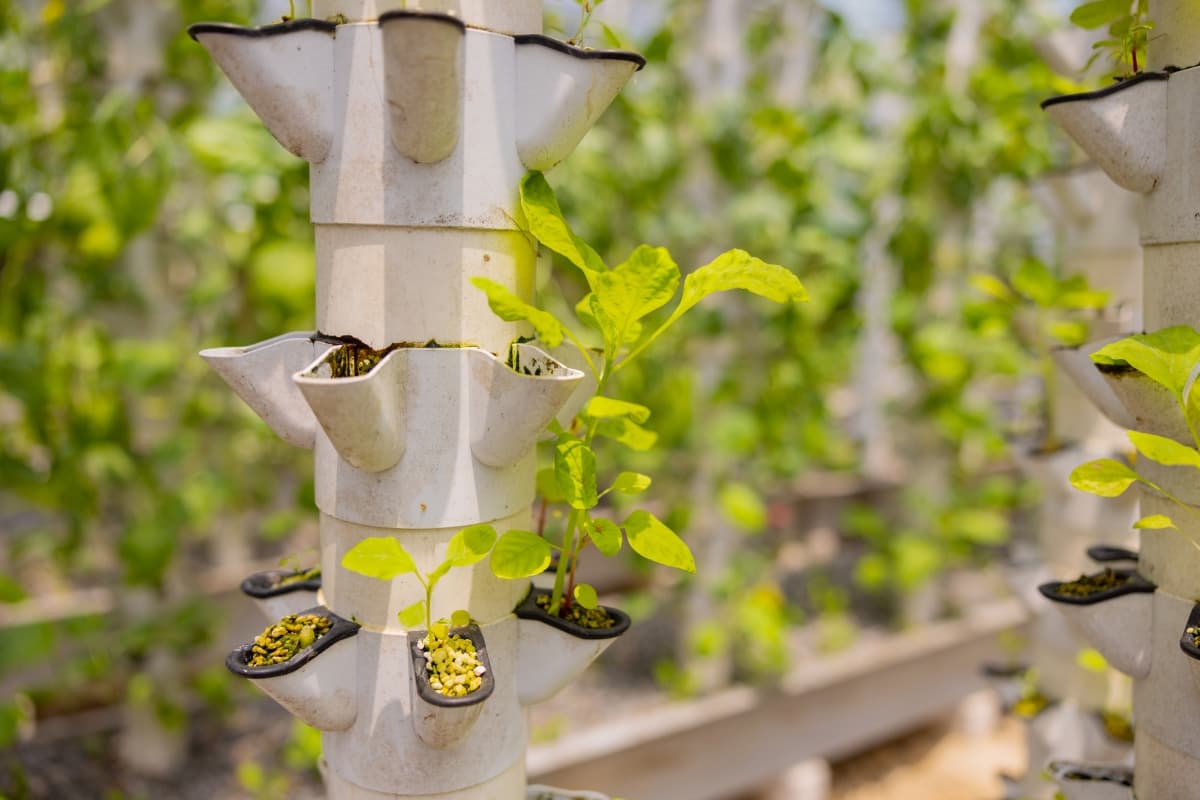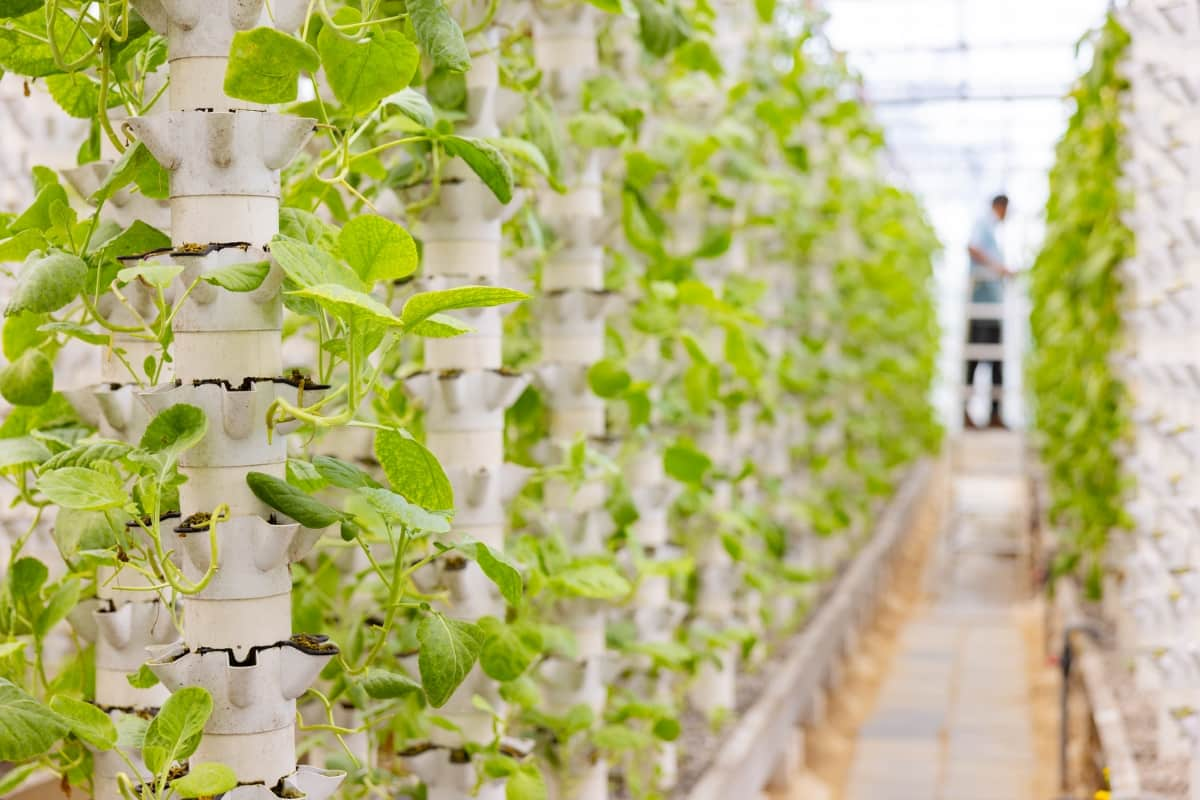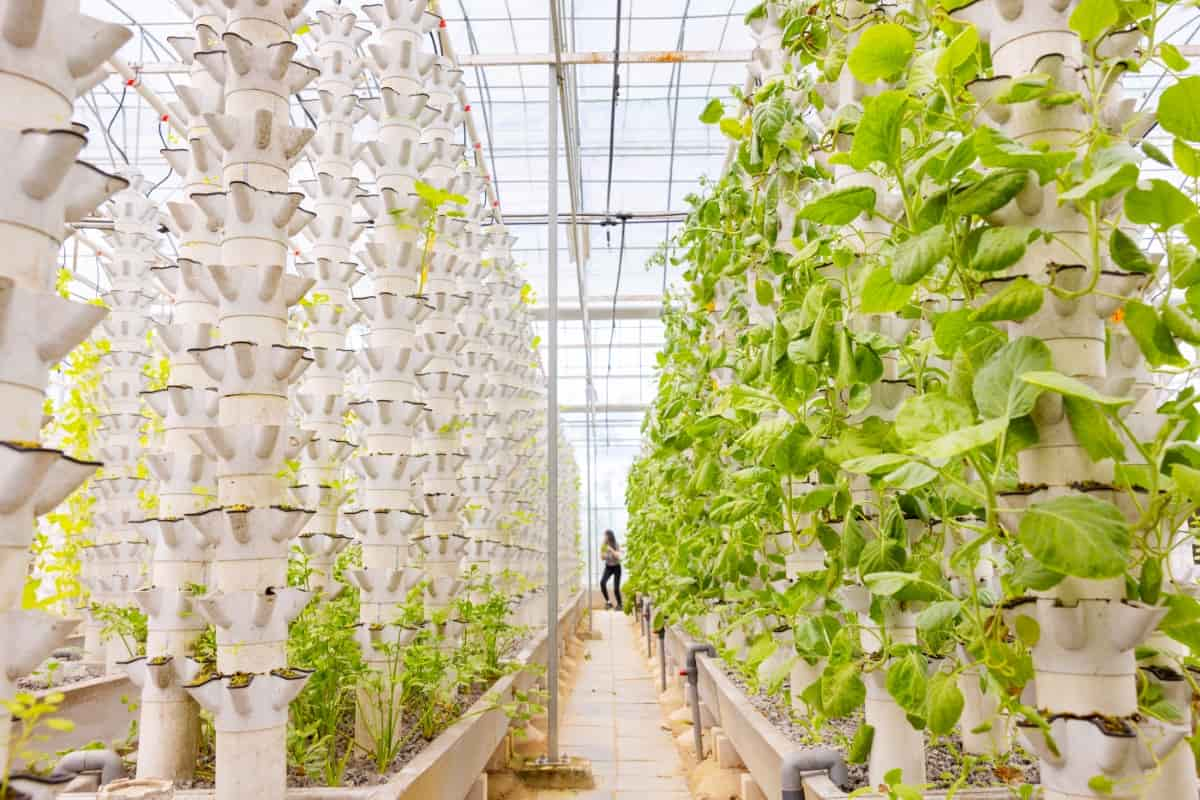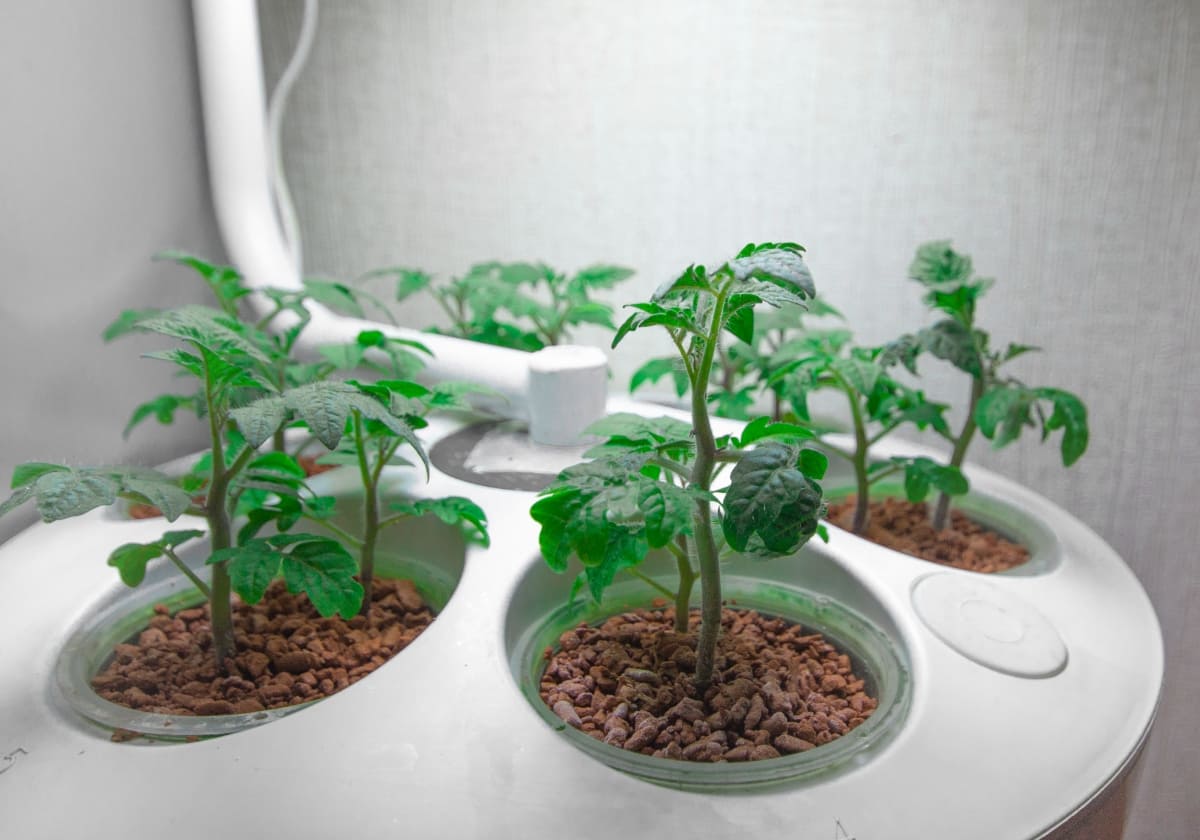Aeroponic urban farming offers a multitude of benefits that make it a very attractive option for sustainable food production in cities. This method allows for the efficient use of space, as plants are grown vertically without soil. Furthermore, aeroponics uses significantly less water compared to conventional agriculture.

Aeroponic Urban Farming
The Benefits
Aeroponic urban farming isn’t just about growing food; it’s about transforming our cities into sustainable ecosystems that produce fresh produce right on our doorsteps. By eliminating the need for soil, aeroponic urban farming offers multiple advantages. It maximizes land utilization by allowing cultivation in urban areas with limited space, such as rooftops or abandoned buildings.
Aeroponics eliminates the need for pesticides and herbicides since pests have limited access to the plant roots suspended in the air. This reduces chemical contamination and promotes organic cultivation practices. Moreover, these farms bring food production closer to consumers’ doorsteps by utilizing underutilized spaces within cities, such as rooftops or abandoned buildings. This promotes local food security while also reducing dependence on imported produce.
Designing an Aeroponic Urban Farm
Firstly, you need to determine the size of your farm based on the available space. Whether it’s a rooftop, balcony, or indoor area, make sure you have enough room for the vertical towers that will hold your plants. Next, think about the types of crops you want to grow. Consider your preferences and market demand when selecting your crop mix. Lighting plays an important role in plant growth in an urban setting where natural sunlight may be limited.
Water management is another key aspect of designing an aeroponic system. A reliable water source with proper filtration is essential to ensure nutrient-rich mist reaches each plant’s roots effectively. Don’t forget about monitoring and automation systems. Investing in sensors that track environmental conditions like temperature and humidity can help optimize productivity by adjusting settings accordingly.
Choosing Suitable Crops
With aeroponics, you have the opportunity to cultivate a wide range of plants, from leafy green vegetables and herbs to flowering crops and even certain fruiting vegetables. Leafy green vegetable plants like lettuce, spinach, and kale are particularly well-suited for aeroponic systems due to their fast growth rate and shallow root systems. These crops thrive in nutrient-rich mist environments, allowing them to reach maturity quickly and produce high yields.
In case you missed it: Vertical Gardening in Urban Apartments: Space-Saving Ideas with Other Benefits

Herbs like basil, cilantro, and mint also flourish in aeroponic setups. While many flowering crops can be grown using aeroponics techniques with great success – think tomatoes or strawberries – it’s important to consider proper support structures that allow these plants’ weight-bearing needs. Trellises or netting can provide essential assistance while preventing damage from heavy fruits.
Nutrient Management
In aeroponics, nutrient solutions are delivered directly to the plant roots using misters or sprayers. To effectively manage nutrients in aeroponics systems, regular monitoring and adjustment are required. Nutrient levels can be measured through electrical conductivity (EC) meters and pH meters. These tools help farmers maintain proper nutrient concentrations by adding or adjusting elements as needed.
Managing Pest and Disease Control
Pests like aphids, whiteflies, and spider mites can still find their way into an aeroponic system through various means, such as wind or contaminated equipment. To combat these pesky invaders, integrated pest management (IPM) techniques are often employed in aeroponics. IPM involves a combination of preventive measures like sterile conditions and proper sanitation practices, along with targeted treatments using organic pesticides or biological controls.
Regular monitoring of the plants is crucial in identifying early signs of pest infestation or disease development. Proper ventilation helps reduce humidity levels and prevents stagnant air pockets where pathogens thrive. Managing pest and disease control in aeroponic systems requires a proactive approach through regular monitoring, implementing integrated pest management techniques, and incorporating preventive measures like proper sanitization practices and good air circulation.
Water Management
To ensure optimal water management in an aeroponic setup, regular monitoring and adjustment are necessary. The amount of moisture delivered to the roots needs to be carefully regulated based on factors such as plant growth stage, temperature, humidity levels, and nutrient requirements. Maintaining a proper pH balance is also essential for effective nutrient uptake by plants.
This can be achieved by testing and adjusting the pH level of the water solution used in the system. Furthermore, maintaining cleanliness within an aeroponic system is vital to prevent the clogging of spray nozzles or the buildup of algae or bacteria that could affect plant health and performance. Regular cleaning routines should include flushing out particulate matter from filters and ensuring proper airflow around root zones.
Energy Efficiency
By using a fine mist of nutrient-rich water, plants can absorb nutrients directly through their roots without the need for excessive watering. In addition, aeroponic systems allow for precise control over temperature and humidity levels, optimizing plant growth while minimizing energy consumption.
With automated controls, farmers can easily adjust these parameters based on specific crop requirements. Another aspect that contributes to energy efficiency in aeroponic farms is the use of LED lights as a source of artificial lighting. Furthermore, by utilizing vertical farming techniques within an aeroponic system, space utilization becomes more efficient.
Economic Viability
Aeroponics, with its efficient use of resources and high crop yield potential, offers promising economic benefits. By eliminating the need for soil and utilizing vertical space, aeroponic systems can maximize land utilization in urban areas. Furthermore, the controlled environment of aeroponic farms minimizes risks associated with weather fluctuations and pests.
As a result, local produce from aeroponic farms can be competitively priced while maintaining freshness and nutritional value. Moreover, the scalable nature of aeroponics enables farmers to start small-scale operations that can gradually expand as demand grows. This flexibility not only lowers initial investment risks but also allows entrepreneurs to test different crops or varieties before committing entirely.
Integration into Urban Infrastructure
By utilizing vertical space and implementing innovative technology, aeroponic farms can be seamlessly integrated into existing urban structures such as rooftops, unused buildings, or even underground spaces. This allows for efficient use of land and reduces the need for transportation of produce from rural areas to cities.
In case you missed it: Sustainable Living: The Growing Trend of Urban Terrace Gardening in Hyderabad

Integrating aeroponics into urban infrastructure also opens up opportunities for job creation and economic development. As more people become aware of the importance of sustainability and local food production, there will be an increased demand for workers in this field. Moreover, these innovative farming practices can attract investments and boost the growth of urban agriculture industries.
Challenges and Future Directions
The main challenge is the initial setup cost, which can be quite high due to the need for specialized equipment and technology. Additionally, there may be issues with finding suitable locations for setting up these farms in densely populated urban areas. Another challenge is ensuring proper nutrient management in aeroponic systems. Since plants rely solely on nutrient-rich mist for their growth, maintaining the right balance of nutrients can be tricky and requires careful monitoring.
Similarly, managing pest and disease control poses a challenge as well since any infestation can spread rapidly throughout the system. The energy required for running pumps, lights, and other equipment needs to be optimized to reduce operational costs and environmental impact. Despite these aeroponics challenges, the future looks promising for aeroponic urban farming. There are already ongoing research efforts aimed at enhancing crop yields through a better understanding of plant responses to different growing conditions.
In case you missed it: How to Start Urban Vegetable Garden at Home: A Step-By-Step Guide for Beginners

Conclusion
Aeroponic urban farming has numerous advantages ranging from space efficiency and high yields to reduced environmental impact and improved accessibility to fresh produce. In this innovative system, crops are suspended in specially designed vertical towers or containers. Instead of being bathed in dirt, their roots hang freely while receiving a nutrient-rich mist spray at regular intervals.
- Feed Your Flock for Less: Top 10 Tips to Save on Chicken Feed
- Ultimate Guide to Ossabaw Island Hog: Breeding, Raising, Diet, and Care
- Hatching Answers: The Top 10 Reasons Your Chickens Aren’t Laying Eggs
- Eggs and Economics: Breaking Down the Cost of Raising Backyard Chickens
- Defend Your Greens: Proven Methods to Keep Iguanas Out of Your Garden
- Ultimate Guide to Cinnamon Queen Chicken: A Comprehensive Guide for Beginners
- Ultimate Guide to California Tan Chicken: Breeding, Raising, Diet, Egg-Production and Care
- Ultimate Guide to Marsh Daisy Chicken: Breeding, Raising, Diet, and Care
- 10 Types of Chicken Farming Businesses You Can Start for Profits